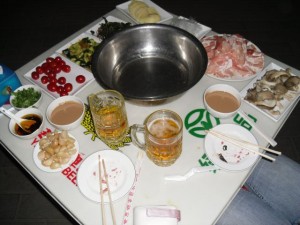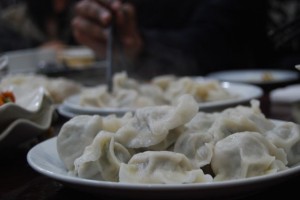In a Chinese Restaurant Posted by sasha on Jul 17, 2013 in Culture, Vocabulary
For anyone planning a trip to China, perhaps the most important language related topic to study is “in the restaurant.” China is home to a vast array of different cuisines, and it would be a shame if you came all the way here and ended up eating McDonald’s and KFC simply because you cannot communicate with restaurant staff or understand a menu. In order to help you out in your quest to eat all of the delicious food that this great country has to offer, here is some useful vocabulary and sentences that you can practice:
First of all, you need to choose a restaurant. You may hear any of the following words used in Chinese – 餐厅 – cān tīng, 饭店 – fàn diàn, or 菜馆 – cài guǎn. In my experiences here, you really can’t go wrong when it comes to choosing a Chinese restaurant. In my humble opinion, the best places are the small, grimy, hole-in-the-wall spots that you’d probably never take your mother too (mine would cry if she saw a selection of my favorite places to eat here). These spots usually have the word snack (小吃 – xiǎo chī) in their name, they are always cheap (便宜的 – pián yi de), and of course, the food is always delicious (好吃 – hǎo chī).
Arriving in the restaurant, you’ll probably be greeted as follows:
Welcome! How many people are in your group? (欢迎光临,你们几位?- huān yíng guāng lín, nǐ men jǐ wèi?)
You should respond with 我们 (number of people) + 位. For example, We have 4 people (我们四位 – wǒ men sì wèi).
Next up, take a look at the menu (菜单- cài dān). If the menu is all in Chinese, you can always give it a shot and ask them, “Do you have an English menu?” (你有英文菜单吗? – Nǐ yǒu yīng wén cài dān ma?). If they do, you can get a little bit of help, but this will only happen in big cities like Beijing and Shanghai. Either way, you’ll eventually need to call out, “Waiter! We’d like to order!” (服务员!点菜!- fú wù yuán! Diǎn cài!). In China, it is perfectly acceptable to yell across the restaurant at the top of your lungs to alert your waiter or waitress. Don’t worry, you won’t be offending anybody, and if you pull the polite, quiet Western food order, you might not get noticed!
Once you’re ready to order, here are a few phrases that can help you out:
What is your specialty? (你们有什么特色菜? – nǐ men yǒu shén me tè sè cài?)
Can you recommend something? (你可以给我推荐一个吗? – nǐ kě yǐ gěi wǒ tuī jiàn yī gè ma?)
I don’t eat meat. (我不吃肉 – wǒ bù chī ròu)
As there is a lot of spicy food in China, your waiter might ask you, “Can you eat spicy food?” (你能吃辣的吗? – nǐ néng chī là de ma?). You can answer with “Yes, I can” (能吃辣的 – néng chī là de) or “No, I can’t” (不能吃辣的 – bù néng chī là de).
When deciding on a dish, here are some Chinese staple dishes (主食 – zhǔ shí) that you should learn:
- noodles ( 面条 – miàn tiáo)
- dumplings (饺子 – jiǎo zi)
- on rice (盖饭 – gài fàn)
- stir-fried food (炒菜 – chǎo cài)
Regardless of where you eat, you are probably going to encounter all of these things on the menu, and by learning a few varieties of each, you will assure that you don’t eat Kung Pow chicken (宫保鸡丁 – gōng bǎo jī dīng) every day, although that isn’t necessarily a bad thing…
Once your food arrives, you had better be ready to put your chopsticks (筷子 – kuài zi) to use, so you don’t have to be that silly, clueless foreigner who asks for a fork (叉子 – chā zi). As it can get messy, you might want to ask your waiter, “Please bring some napkins” (请来一些餐巾纸 – qǐng lái yī xiē cān jīn zhǐ).
When everyone is full and it’s time to go, you’re ready to get the bill (买单 – mǎi dān). You can either treat your guest (请客 – qǐng kè) or go Dutch (AA制 – AA zhì) when it comes to paying up.

Build vocabulary, practice pronunciation, and more with Transparent Language Online. Available anytime, anywhere, on any device.
About the Author: sasha
Sasha is an English teacher, writer, photographer, and videographer from the great state of Michigan. Upon graduating from Michigan State University, he moved to China and spent 5+ years living, working, studying, and traveling there. He also studied Indonesian Language & Culture in Bali for a year. He and his wife run the travel blog Grateful Gypsies, and they're currently trying the digital nomad lifestyle across Latin America.








Comments:
Ali:
Very well written , but i suppose first time visitors wont be able to pronounce or speak that much of chinese without proper learning .. But very well elaborated for those who have some idea abt pin yin .
加油。
Jason:
Wonderful article Sasha. It’s very important to taste the native food. Even though you don’t know how to speak Chinese, you can always learn basic Chinese related to traveling, shopping,etc. You can use mobile apps for the Pinyin system, so that your pronunciation will not go wrong.
David Lloyd-Jones:
Sasha,
Would you really say For example, We have 4 people (我们四位 – wǒ men sì wèi)?
Correction please if I’m wrong, but I thought of 位 as an honorific, hence the other person’s group would be counted by wèi, but one’s own group by rén 人, if not by chóng 虫, péng bì 蓬荜, or dé bó néng xiǎn 德薄能鲜 ?
Best,
-dlj.
sasha:
@David Lloyd-Jones That’s always how I respond in restaurants, because the question is usually “你们几位?” That’s how I learned it and it seems to be the norm, at least in Beijing!